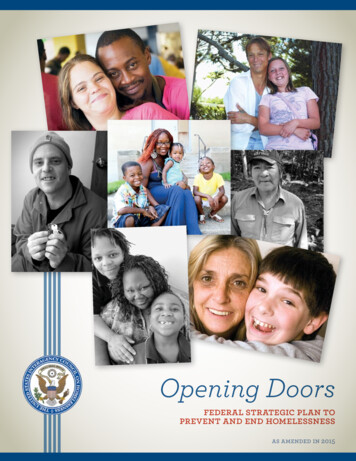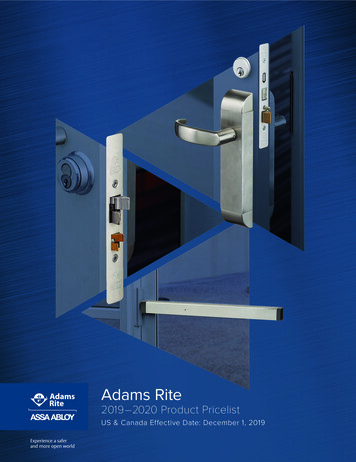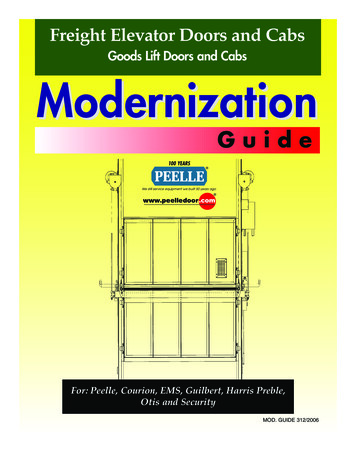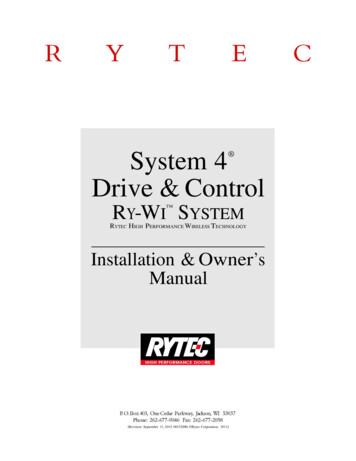
Transcription
Opening Doorsfederal strategic plan toprevent and end homelessnessas amended in 2015
United States Interagency Council on Homelessnessdepartment of agriculturedepartment of laborSecretary Tom VilsackSecretary Thomas Perezdepartment of commercedepartment of transportationSecretary Penny PritzkerSecretary Anthony Foxxdepartment of defensedepartment of veterans affairsSecretary Ashton CarterSecretary Robert McDonalddepartment of educationcorporation for nationaland community serviceSecretary Arne Duncandepartment of energySecretary Ernest Monizdepartment of healthand human servicesSecretary Sylvia Matthews Burwelldepartment of homeland securitySecretary Jeh Johnsondepartment of housing andurban developmentChief Executive Officer Wendy Spencergeneral services administrationActing Administrator Denise Turner Rothoffice of management and budgetDirector Shaun Donovansocial security administrationActing Commissioner Carolyn Colvinu.s. postal servicePostmaster General Megan BrennanSecretary Julián Castrodepartment of interiorSecretary Sally Jewellwhite house office of faith-basedand neighborhood partnershipsExecutive Director Melissa Rogersdepartment of justiceunited states interagency councilon homelessnessAttorney General Loretta LynchExecutive Director Matthew Doherty
Opening Doorsfederal strategic plan toprevent and end homelessnessas amended in 2015united states interagency council on homelessness washington, d.c., june2015
It is simply unacceptable for individuals, children, families and ournation’s Veterans to be faced with homelessness in this country.president obamajune 18, 2009
ContentsLetter from President Obama4Preface from the Chair5Message from the Executive Director5Executive Summary6Homelessness in America12The Response to Homelessness14Sources of Data15How Many People Experience Homelessness?16Families with Children17Unaccompanied Youth21Individual Adults23Individuals Experiencing Chronic Homelessness24Veterans26SystemsThe Plan2831Increase Leadership, Collaboration,and Civic Engagement32Increase Access to Stable and Affordable Housing38Increase Economic Security43Improve Health and Stability49Retool the Homeless Crisis Response System55The Steps: Framework for Action59References71Margin Notes and Narratives71Endnotes73
president obama’s prefatory letter was written for, and first reproduced in, the 2010 edition of opening doors
Preface from the ChairI have been honored to serve as the Chairof the United States Interagency Council onHomelessness (USICH), and to carry forwardthe work begun by my esteemed colleagueswho have also served in this role in the ObamaAdministration. I am pleased to present thisamended and updated Opening Doors: FederalStrategic Plan to Prevent and End Homelessnessand I am certain that it will advance ourshared progress toward ending homelessnessnationally and in local communities.As a nation, we have made great stridessince Opening Doors was first released in2010. Unprecedented collaboration across theFederal government and among states, localcommunities, advocates, and private and nonprofit partners has resulted in the reduction ofhomelessness across all populations. Since theadoption of the original plan, homelessnessamong Veterans has been reduced by 33percent, including an incredible 43 percentreduction in the number of Veterans and theirfamilies living on the streets. The number ofindividuals experiencing chronic homelessnesshas fallen by 21 percent. Homelessnessamong families with children has decreased15 percent, including a 53 percent reductionin unsheltered homelessness among families,and we have more knowledge about the uniquecircumstances of homelessness among youththan ever. While our work is not finished, ourprogress thus far is proving that homelessnessis not the intractable problem many oncethought it to be, but a problem we can solve.By issuing this amended and updatedversion of Opening Doors, we reaffirm ourcommitment to end homelessness inAmerica, with even greater confidence inour collective ability to solve this problem.thomas e. perez, u.s. secretary of laborMessage from the Executive DirectorUSICH and our Federal partners are pleasedto release the 2015 Amendment to OpeningDoors. This edition sustains core elements ofthe original Plan, includes new strategies todrive increased progress, and reflects whatwe have learned since 2010 when OpeningDoors was first launched. Our intention is toensure that the Plan serves as a living blueprint,containing the latest knowledge and bestpractices to prevent and end homelessness.This Amendment was informed by valuablestakeholder input gathered through many different forums. Key new elements include: theoperational definition for an end to homelessness; clarifications regarding the role of Medicaidin financing services for permanent supportivehousing; an updated discussion of the use ofmetrics and accountability as important tools forending all homelessness; improved guidance andstrategies for retooling homelessness servicesinto efficient and effective crisis response systems; and the incorporation of changes madeby the 2012 Amendment.The Amendment also adjusts the goal of endingchronic homelessness from 2015 to 2017. Thischange reflects the need for additional resourcesto achieve this goal nationally, although we urgestates and communities able to achieve thegoal with current resources to continue to actwith urgency. The President’s FY 2016 Budgetwould bring the nation’s inventory of permanentsupportive housing to a scale needed to achievean end to chronic homelessness in 2017.We’re releasing this Amendment at a criticalmoment for the country; the time to act is nowto achieve all of the goals of Opening Doors. I amproud to be working alongside so many determined colleagues and partners to ensure that allAmericans have a safe, stable place to call home.usich executive director matthew doherty
executive summaryExecutive SummaryOur nation has made significant progress since the launch of this Plan in 2010. Together, weare proving that homelessness does not have to appear in the pages of the American storyas a permanent fixture, but as a problem the American people overcame. Homelessness isa problem we can solve. Even in the aftermath of an economic recession, when historicaldata would suggest an increase in homelessness, homelessness overall is down—demonstrating that our strategies are working. Communities across the United States—from rural Mankato, Minnesota to urban Los Angeles—have committed to the goals ofOpening Doors and have organized partnerships between local and state agencies and withthe private and nonprofit sectors to prevent and end homelessness. These communities, inpartnership with the Federal government, are creating unprecedented local collaboration,using data to drive results, targeting resources strategically, and investing in the evidencebased practices we know work to end homelessness.Since the launch of Opening Doors in 2010, we have reduced homelessness amongVeterans by 33 percent, chronic homelessness by 21 percent, and family homelessnessby 15 percent. Our progress shows we are on the right track. We now know more aboutthe scope and dynamics of youth homelessness. We are focused on bringing to scale theinterventions and best practices that will help our nation’s youth achieve stable housing,permanent connections, education and employment, and well-being. While homelessnessamong families has declined since 2010, we remain concerned about the scale of familyhomelessness as well as the growing number of renters with very low incomes who do notreceive government housing assistance and who either pay more than half their monthlyincome for rent, live in severely substandard housing, or both.To achieve the goals of this Plan, we must expand and accelerate our efforts. Communitieswill need to retool systems to better meet the needs of those experiencing homelessnesstaking into account the varying needs of our nation’s Veterans, individuals experiencingchronic homelessness, families, and far too many of our youth.In 2010, the Obama Administration declared the vision of Opening Doors to be centeredon the belief that “no one should experience homelessness, no one should be withouta safe, stable place to call home.” As amended by this document, the Plan sets, andremains focused on, four key goals: (1) Prevent and end homelessness among Veteransin 2015; (2) Finish the job of ending chronic homelessness in 2017; (3) Prevent and endhomelessness for families, youth, and children in 2020; and (4) Set a path to end alltypes of homelessness.The goals and timeframes we set in this Plan are an important target for the nation. Theydemonstrate the Council’s belief that ending homelessness in America must be a priorityfor our country. As President Barack Obama has said, “it is simply unacceptable for individuals, children, families, and our nation’s Veterans to be faced with homelessness.” Webelieve it is important to set bold and measurable goals for true progress to be made.This Plan is a roadmap for joint action by the 19 member agencies (the Council) of the UnitedStates Interagency Council on Homelessness (USICH) along with local and state partnersin the public and private sectors. It provides a framework for the allocation of ness
executive summaryand the alignment of programs to prevent and end homelessness in America. The Planalso proposes the realignment of existing programs based on what we have learned andthe best practices that are occurring at the local level, so that resources are invested inwhat works. We will continue to take action in partnership with Congress, states, localities,philanthropy, and communities around the country.From years of practice and research, we have identified successful approaches to endhomelessness. Evidence points to the role housing plays as an essential platform for humanand community development. Stable housing is the foundation upon which people buildtheir lives—absent a safe, decent, affordable place to live, it is next to impossible to achievegood health, positive educational outcomes, or reach one’s economic potential. Indeed, formany persons living in poverty, the lack of stable housing leads to costly cycling throughcrisis-driven systems like emergency rooms, psychiatric hospitals, detox centers, and jails.By the same token, stable housing provides an ideal platform for the delivery of health careand other social services focused on improving life outcomes for individuals and families.Researchers have focused on housing stability as an important ingredient for the successof children and youth in school. When children have a stable home, they are more likely tosucceed socially, emotionally, and academically.Capitalizing on these insights, this Plan builds on previous reforms and the intent by theObama Administration to directly address homelessness through intergovernmentalcollaboration. Continued successful implementation of this Plan will result in stability andpermanency for the more than 578,000 men, women, and children who are homeless on asingle day in America. At the same time, its execution produces cost-effective approachesto homelessness for local, state, and Federal government. The Plan’s content presentsgoals, themes, objectives, and strategies and was generated through the collaboration andconsensus of the Council member agencies. The substance of this Plan drives progresstoward the goal of preventing and ending homelessness. An annual update is submitted toCongress pursuant to the McKinney-Vento Homeless Assistance Act as amended by theHomeless Emergency Assistance and Rapid Transition to Housing (HEARTH) Act.Larimer, ME, et al., 2009The Affordable Care Act, a landmark achievement of the Obama Administration, furthersthe Plan’s goals by helping numerous families and individuals experiencing homelessnessget the health care they need. All states now have the opportunity to expand Medicaideligibility to nearly all individuals under the age of 65 with incomes up to 133 percent of theFederal poverty level (currently about 15,500 for a single individual). As of May 2015, 30states including the District of Columbia have acted to expand their Medicaid programs. Thissignificant expansion allows more families and adults without dependent children to enrollin Medicaid. Medicaid provides for both physical health and behavioral health care includingsubstance use disorder treatment. In addition, the Affordable Care Act includes a number ofservice delivery demonstrations to improve the quality of health care. For example, Centerfor Medicare and Medicaid Service’s (CMS) Health Care Innovation Awards have providedgrant funds to test innovative models of care delivery, including grants specifically focusedon people experiencing homelessness. CMS’s State Innovation Model grants are assistingstates to experiment with new benefits and payment systems that can improve services forpeople experiencing homelessness. The Affordable Care Act has also encouraged states topursue care delivery innovations for high need populations, including people experiencinghomelessness through 1115 waivers and the health home state plan option. The Affordable7Opening Doors: federal strategic plan to prevent and end homelessness » 2015In Seattle, Washington,a permanent supportivehousing site using HousingFirst practices experienced anaverage savings of 2,449 perperson per month in publicservice costs after 6 monthsof intervention (including jail,hospitalizations, detoxificationtreatment, emergency, andMedicaid-funded services).
executive summaryCare Act also expands community health centers, increasing access to care for manyvulnerable populations, and provides states with new options to better serve people withcomplex conditions, including Medicaid Health Homes for people with multiple chronicillnesses.Opening Doors has advanced a set of strategies that call upon the Federal government towork in partnership with state and local governments, as well as the private and not-forprofit sectors to employ cost effective, comprehensive solutions to end homelessness.The Plan recognizes that the Federal government needs to be smarter and more targetedin its response and role, which also includes supporting the work that is being done onthe ground. The Federal government’s partners at the local level have made tremendousstrides, with more than 1,000 communities across the nation having developed plansto end homelessness. More recently, more than 600 mayors, governors, and countyexecutives have joined the Mayors Challenge to End Veteran Homelessness in 2015. ThePlan highlights that by collaborating at all levels of government, the nation can create asystematic response that will ensure that homelessness is prevented whenever possibleand when it cannot be prevented, is rare, brief, and non-recurring.Opening Doors includes 10 objectives and 66 strategies. These objectives and strategiesguide the nation toward accomplishing all four goals of this Plan and are summarized onpages 31-58.The first section details the development of this first-ever comprehensive Federal plan toprevent and end homelessness. This section sets out the core values reflected in the Planand the key principles that guided the process. It also describes the opportunities for publicinput offered during the development of the Plan and its amendments.The second section of the plan provides an overview of homelessness in America. Sincehomelessness takes many different forms by population or geographic area, we provide asynopsis of the issues facing these varying groups experiencing homelessness. The sectionalso addresses the sources of data used throughout the Plan.The third section represents the core of the Plan including the objectives and strategies toprevent and end homelessness. It provides the logic behind each objective, the departmentsand agencies involved, the key partners, and strategies to achieve the respective objectives.The Plan concludes with a section that defines the steps the Council is taking, providing ourframework for action. Specifically, it situates the impact we aspire to have in the current political and economic context, the actions we are taking, and how we measure performanceon implementation. Finally, the section lays out the documents USICH will produce to provide information and transparency to the public, Congress, and our partners going forward.The issuance of the 2015 Amendment to Opening Doors represents the second time thatthe Plan has been amended since its original release in 2010. The Plan was first amended in 2012 to include additional information and strategies around youth homelessness,and those changes are incorporated into this document. The 2015 Amendment further updates the Plan in several areas. In large part due to a lack of Congressional support for theexpansion of permanent supportive housing, we will not finish the job of ending ss
executive summaryhomelessness in 2015. The 2015 Amendment adjusts the timeline on that goal to 2017, butthis timeline assumes that Congress will support the President’s FY 2016 Budget, whichincludes increased funding to support the new permanent supportive housing needed toend chronic homelessness. The 2015 Amendment includes content to support the retooling of homeless programs into crisis response systems. It clarifies the role of Medicaid incovering services that support housing stability, and emphasizes the strategic use of data.In developing the 2015 Amendment, it was affirmed that Opening Doors is still the right plan,with the right goals and objectives. Changes to the Plan in 2015 reflect the progress wehave made because of its implementation, further strengthening our strategies based onwhat we know works to end homelessness.VISIONTHEMESNo one should experiencehomelessness—no oneshould be without a safe,stable place to call home.Increase Leadership, Collaboration, and Civic EngagementGOALS Prevent and endhomelessness amongVeterans in 2015 Finish the job ofending chronichomelessness in 2017 Prevent and endhomelessness forfamilies, youth, andchildren in 2020 Set a path to ending alltypes of homelessnessObjective 1:Provide and promote collaborative leadership at all levels of government andacross all sectors to inspire and energize Americans to commit to preventingand ending homelessnessObjective 2: Strengthen the capacity of public and private organizations by increasingknowledge about collaboration, homelessness, and successfulinterventions to prevent and end homelessnessIncrease Access to Stable and Affordable HousingObjective 3: Provide affordable housing to people experiencing or most at risk ofhomelessnessObjective 4: Provide permanent supportive housing to prevent and end chronichomelessnessIncrease Economic SecurityObjective 5: Improve access to education and increase meaningful and sustainableemployment for people experiencing or most at risk of homelessnessObjective 6: Improve access to mainstream programs and services to reduce people’sfinancial vulnerability to homelessnessImprove Health and StabilityObjective 7: Integrate primary and behavioral health care services with homelessassistance programs and housing to reduce people’s vulnerability to and theimpacts of homelessnessObjective 8: Advance health and housing stability for unaccompanied youth experiencinghomelessness and youth aging out of systems such as foster care andjuvenile justiceObjective 9: Advance health and housing stability for people experiencing homelessnesswho have frequent contact with hospitals and criminal justiceRetool the Homeless Crisis Response SystemObjective 10: Transform homeless services to crisis response systems that preventhomelessness and rapidly return people who experience homelessness tostable housing9Opening Doors: federal strategic plan to prevent and end homelessness » 2015
executive summaryOperational Definition of an End to HomelessnessProgress in communities and across the nation over the last few years has affirmed thatan end to homelessness is an achievable goal and can be measured. A clear definitionof what an end to homelessness means, supported by specific metrics, will ensure thatFederal, state, and local partners are working towards a shared vision and goal.Definition:An end to homelessness does not mean that no one will ever experience a housingcrisis again. Changing economic realities, the unpredictability of life, and unsafe orunwelcoming family environments may create situations where individuals, families, oryouth could experience, re-experience, or be at risk of homelessness.An end to homelessness means that every community will have a systematic responsein place that ensures homelessness is prevented whenever possible or is otherwise arare, brief, and non-recurring experience.Specifically, every community will have the capacity to:10uQuickly identify and engage people at risk of and experiencing homelessness.uIntervene to prevent the loss of housing and divert people from entering thehomelessness services system.uProvide immediate access to shelter and crisis services, without barriers toentry, while permanent stable housing and appropriate supports are beingsecured.uWhen homelessness does occur, quickly connect people to housingassistance and services—tailored to their unique needs and strengths—tohelp them achieve and maintain stable ss
executive summaryDevelopment of the PlanThe President and Congress charged USICH to develop “a national strategic plan” to endhomelessness with enactment of the HEARTH Act in May 2009. This Federal Strategic Planto Prevent and End Homelessness reflects agreement by the Council on a set of priorities andstrategies.In developing the Plan and ensuing amendments, the Council was guided by the principlesof collaboration, evidence-based solutions, cost-effectiveness, ease of implementation,longevity and scalability, as well as measurement and accountability.We stressed the importance of transparency. We encouraged multiple opportunitiesfor input, feedback, and collaboration in the development of the Plan from researchers,practitioners, state and local government leaders, advocates, people who have experiencedhomelessness, and Federal agency staff.We obtained input from more than 750 leaders of regional and state interagency councilsand stakeholders from across the country. We gathered more input through meetings andconference calls with mayors, congressional staff, the National Alliance to End Homelessness Leadership Council, and the National Health Care for the Homeless Consumer Advisory Board. A number of organizations submitted written comments.We also produced an interactive website for public comment on the Plan’s themes thatproduced 7,734 visits and 2,318 individual comments. The site was promoted in the Council’s e-newsletter distributed to more than 19,000 stakeholders, as well as an advertisementplaced in eight of the North American Street Newspaper Association’s newspapers (withcirculation to over 150,000).Input included a broad range of perspectives from both external and Federal governmentstakeholders on the challenges, priorities, and strategies for preventing and endinghomelessness in America. All input helped to inform the Plan’s priorities and strategies.The 2012 and 2015 amendments reflect USICH’s commitment to including up-to-dateknowledge of evidence-based practices. For both amendments, USICH adhered to thesame principles of development as in the original Plan, and again, there was a heavy focus on public participation. Combined, USICH collected nearly 4,000 public commentsthrough an online forum that reached nearly 8,000 stakeholders nationwide. Additionally,for the 2015 Amendment, we collected input from hundreds of stakeholders from community forums in 10 locations across the U.S.We look forward to continuing this important dialogue as we offer opportunities for ongoing input. We will work with key stakeholders to implement the Plan, as well as update thePlan annually to reflect the most current research and information on homelessness.11Opening Doors: federal strategic plan to prevent and end homelessness » 2015
homelessness in americaFive years ago, Karen experiencedhomelessness and lived in her car aftersurviving domestic violence. "Thecaseworkers from Southwest Solutionsactually came to my car to find meand help me and my children," Karensays. "They opened up their armsand surrounded us with care.” Karenand her children obtained permanenthousing in one of their apartments.Homelessness in America“Now that our living situation is stable,I want to do more with my life. I'vestarted culinary arts school. I want tobe a chef, and maybe work on a cruiseship one day. I'd love to travel andsee more of the world with my ss
homelessness in americaHomelessness takes many forms, and people who are at risk of homelessness can be foundin many types of unstable living arrangements. The most visible face of homelessness isthat of a person living on the street. When we refer to people who are unsheltered, we arereferring to people who live on the streets, camp outdoors, or live in cars or abandonedbuildings. Some people who experience homelessness, including some people who arefleeing domestic violence, stay in emergency shelters or transitional housing; this group isreferred to as sheltered. Some people experience housing crises that result in evictions orinvoluntary moves. Many people who are experiencing a housing crisis or unable to finda place to live because of economic hardship turn to family or friends who can providea place to stay, at least temporarily, and they may be referred to as doubled-up. Someof these arrangements can be relatively stable, but sometimes families, youth, or otherindividuals may be “couch surfing” from one place to another, unable to stay anywhere formore than a few days at a time. Some families with children are living in motels, hotels, orother places that are severely overcrowded and not safe, permanent homes.While everyone needs safe, stable housing, health care, income, and community support,this Plan provides a framework for addressing the needs of people who experience homelessness. There are specific approaches and programs that are designed to help people whoexperience homelessness, including those experiencing chronic homelessness, Veterans,families with children, and unaccompanied youth and young adults.Housing Affordability inAmerica by the NumbersTo afford a two-bedroomapartment in the U.S.you need, on averagean annualincome of 39,360ora full-time job withan hourly wage ofor2.6 full-time jobsat minimum wageThe estimatedmean renter wagein the U.S. isNLIHC, 2014 18.92 14.64The Plan acknowledges and supports the full range of Federal definitions of homelessness as prescribed in statute, as each plays an appropriate and essential role in supporting and stabilizing those whom they are intended to help. A common language isnecessary for this Plan to be understandable and consistent. This language does notembrace or negate the definitions used in different programs. The challenge then is howto speak with one voice that helps all families and individuals in need without creatingfractures in the systems intended to improve their circumstances. If we are to truly endhomelessness, we must use all resources that exist, both those that are intended specifically for homeless populations and those that are available for a broader segment of thepopulation, to create lasting bridges across current gaps in housing and services.Nationwide, after a period of rising homelessness that began in the 1980s, homelessnessbegan to decline in 2007 and has declined at an increased rate since the launch ofOpening Doors in 2010.1 Thirty-five years ago, while people sometimes experiencedevictions or involuntary moves because of personal or financial crises, homelessnesswas predominantly experienced by single adults. Prior to the 1980s, in most Americancommunities there was a sufficient supply of rental housing that was affordable to lowincome families, and as a result homelessness among children and youth did not existin the same way it does today. When families experienced crises and lost their housing,they could quickly find another place to live, and affordable options were available foryoung people living on their own.Over the last three decades the number of people experiencing homelessness remainedhigh even in good economic times. More recently, during the Great Recession, many familiesexperienced extraordinary hardships and housing crises as a result of unemployment andforeclosures. With strategic investments of both public and private funding, across thecountry many communities implemented more effective and well-targeted interventions13Opening Doors: federal strategic plan to prevent and end homelessness » 2015
homelessness in americato prevent and end homelessness. As a result of these efforts, in most communitieshomelessness did not increase, and nationwide fewer families and individuals experiencehomelessness today.The increase in homelessness since the 1980s was the result of a convergence of severalkey factors: the loss of affordable housing and increase in foreclosures; wages and publicassistance that have not kept pace with rising housing costs and the cost of living, in partas a result of job loss and underemployment, and resulting debt; and the closing of statepsychiatric institutions without the concomitant creation of sufficient community-basedhousing and services. The rapid increase in income inequality that began during the 1980shas contributed to changes in local housing markets, driving up the cost of renting e
Increase Access to Stable and Affordable Housing 38 Increase Economic Security 43 Improve Health and Stability 49 Retool the Homeless Crisis Response System 55 . Since the launch of Opening Doors in 2010, we have reduced homelessness among Veterans by 33 percent, chronic homelessness by 21 percent, and family homelessness










